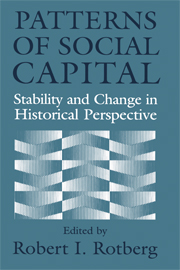Book contents
- Frontmatter
- Contents
- Introduction Social Capital and Political Culture in Africa, America, Australasia, and Europe
- Articles
- Civic Traditions in Premodern Italy
- The Sources of Civil Society in Italy
- Finding Social Capital: The French Revolution in Italy
- Social Capital in the Early Industrial Revolution
- The Diversity of Social Capital in English Communities, 1300–1640 (with a Glance at Modern Nigeria)
- Social and Cultural Capital in Colonial British America: A Case Study
- The Growth of Voluntary Associations in America, 1840–1940
- Civil Society as Democratic Practice: North American Cities during the Nineteenth Century
- Securing Political Returns to Social Capital: Women's Associations in the United States, 1880s–1920s
- Second-Generation Civic America: Education, Citizenship, and the Children of Immigrants
- Human Capital and Social Capital: The Rise of Secondary Schooling in America, 1910–1940
- From Local to National Political Cultures: Social Capital and Civic Organization in the Great Plains
Second-Generation Civic America: Education, Citizenship, and the Children of Immigrants
Published online by Cambridge University Press: 12 April 2010
- Frontmatter
- Contents
- Introduction Social Capital and Political Culture in Africa, America, Australasia, and Europe
- Articles
- Civic Traditions in Premodern Italy
- The Sources of Civil Society in Italy
- Finding Social Capital: The French Revolution in Italy
- Social Capital in the Early Industrial Revolution
- The Diversity of Social Capital in English Communities, 1300–1640 (with a Glance at Modern Nigeria)
- Social and Cultural Capital in Colonial British America: A Case Study
- The Growth of Voluntary Associations in America, 1840–1940
- Civil Society as Democratic Practice: North American Cities during the Nineteenth Century
- Securing Political Returns to Social Capital: Women's Associations in the United States, 1880s–1920s
- Second-Generation Civic America: Education, Citizenship, and the Children of Immigrants
- Human Capital and Social Capital: The Rise of Secondary Schooling in America, 1910–1940
- From Local to National Political Cultures: Social Capital and Civic Organization in the Great Plains
Summary
The onset of recurrent mass immigration forced the United States to deal with a new problem—“the preservation of the ability of people of dissimilar origins to act together under dissimilar conditions.” Public institutions and ethnic groups faced the challenge of creating forms of social capital that would facilitate the crossing of boundaries for social and civic participation. Putnam has described the complex of networking, norms, and mutual social trust bringing together different groups in pursuit of common social and civic objectives as “bridging” social capital.
Both the public schools and settlement houses of the Progressive era directed creative forces for organizing social and civic networks to overcome group divisions. These institutions were, in part, a reaction to the putative weakness of “bridging” social capital in immigrant communities in an attempt to advance public spiritedness and commitment to the public interest. Progressiveera educators and settlement workers, responding to the perception that the nation had become a society of myriad sub-communities isolated and alienated from each other, identified a “second-generation problem”: Deprived of both upbringing in their ancestral homeland and assimilation into their host society, the children of immigrants existed in a transnational vacuum. To fill this civic void, schools and settlement houses exposed members of this second generation to an ideology of Americanization and a program of citizenship training. These structures of civic acculturation had the potential to be converted into instruments for increasing their inclusion in politics and other spheres of public life.
- Type
- Chapter
- Information
- Patterns of Social CapitalStability and Change in Historical Perspective, pp. 273 - 294Publisher: Cambridge University PressPrint publication year: 2000



